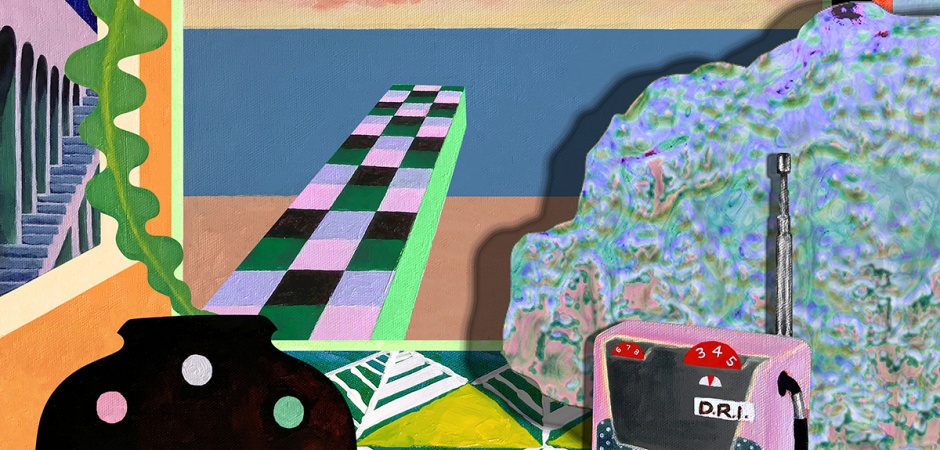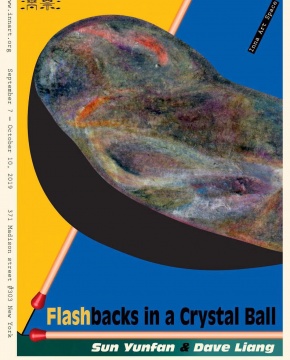Demystify the Romance trope
by Peiyue Wu
“Art should stay as a space for solitude and reflection rather than romantic comfort.”
The romantic anecdotes of a collaborative couple are often more evocative than general stories about an artist’s inner growth. They can act as mental opium to feed the nerves of those who feel abandoned to their lusterless fate. Just as people of the past used to seek therapeutic power through religion, today’s art practitioners and art lovers tend to consider art as a panacea helping them push through spiritual desolation. It has the potential to connect them to like-minded souls, most ideally, to someone who can provide romantic comfort. Understanding this, it is not surprising that a recent exhibition featuring visual presentation by a collaborative couple at Inna Art Space, titled Sun Yunfan & Dave Liang: Flashbacks in a Crystal Ball, could easily make a scene among the Chinese community in New York City. This is in addition to the fact that the two artists also perform as an electronic music duo, Shanghai Restoration Project, popularized both in China and the United States due to skillful integration of romanticism and nostalgia into their music.
Shanghai Restoration Project was initially founded in 2006 by Dave Liang, a Chinese American who grew up in Upstate New York and aspired to create music synthesizing Western-leaning beat music with 1930’s Shanghai jazz. Compared to Liang, Yunfan Sun’s navigation toward music was much more circuitous. Born and raised in China, Sun relocated to the United States to pursue a master's degree in accounting, though she eventually redirected her career to art. After earning a BFA from the School of Visual Art and an MFA from the Pratt Institute, Sun worked as a cultural journalist before joining Shanghai Restoration Project as a music producer and visual director at a relatively late stage. Although Liang had been collaborating with different musicians and animators, it was not until he paired up with Sun that the band developed a much stronger chemistry between music and visual presentation, therefore expanding its influence to a larger circle of art lovers.
Though the concept of “artist collaboration” is used as bait to trigger public curiosity for the show, the only collaborative artwork exhibited is an autobiographical assemblage that strings together the creative trajectories of both artists. Despite the lack of legitimacy in terms of the format (as a two-person exhibition), the presentation of the show, in my eyes, does have an unexpected effect in discouraging the mindless mythologization of the romantic aspect of collaborative couples. The exhibition showcases a series of enlarged prints of album covers designed by Sun, while sealing the music co-produced by the two within special edition cassettes and vinyl records. This two-person exhibition actually functions more as a celebration of Sun’s contributions to Shanghai Restoration Project as an active agent and an affirmation of her identity as a visual artist alongside her pursuits in music.
The illustration on a record sleeve never merely advertises the music, as the visual strength of the design supplements the lyrics in terms of communicating concrete ideas behind the music. On the record sleeve of R. U. R, an album responding to Google’s DeepMind AI that defeated the world’s top Go champions, Sun reconstructs a chessboard into a labyrinth-like architectural space. Above that, a hand, positioned like it is about to play a keyboard, approaches a chess piece to make the next move. Deconstructing and recomposing different signifiers, Sun creates a visual puzzle indicating her presumption about the future relationship between art and technology; when the spontaneity of music composition and the complicated calculation of chess-playing both lose their original association with human intelligence, the apparent differences between the two intellectual activities will no longer exist. In addition to the dichotomy between human and artificial intelligence, Sun introduces a third party: plants. The chess pieces with binary code written in Chinese characters hang on two plants just like fruits growing from branches. The circuit which connects individual chess pieces on the plant hints at the metabolism of natural substance, thus providing another potential reading of the image that contradicts an anthropocentric worldview: as the overwhelming binary logic is simply something rooted in genetic codes of natural substances, the victory of AI is an ultimate manifestation of a cosmology never fully understood by human beings since ancient times. Visualizing such a complicated power dynamic among different elements requires a large amount of intellectual labor.
Moreover, the way Sun feeds the music with a modern interpretation of Eastern philosophy aligns with the Shanghai Restoration Project’s mission in integrating elements and ideas from Chinese culture into a Western form of music. In Chinese art history, natural substances like plants and rocks were originally associated with a unified, omniscient cosmos. However, within the modernization and urbanization process started during the Ming Dynasty, there emerged a new genre of paintings depicting domestic space, within which plants and rocks always refer to feminine concepts such as sentimentality and melancholy. Legitimizing biocentrism within a sci-fi setting, Sun seems to playfully suggest that plants always know more about the future than humans do, whereas humans constantly redefine the future by technology but ultimately lose their initiative. With such an idea tapping into the paradox of human history, Sun elevates the status of plants, which are usually regarded as inferior to humans. By doing this, she empowers the cosmological expedition conducted within art, which appears to be less progressive compared to those heroic endeavors pushing technological development.
The overall sense of quietness and solitude that you can feel through Sun’s art does not mean that it is not aggressive. Her visual strategy of juxtaposing unrelated objects to provoke deeper thoughts can be understood as a conscious resistance to an indolent mind. The more time you spend with Sun’s images, the more you are going to believe that they appeal to the contemplative mind for deeper meaning rather than to the hungry eye for immediate satisfaction.With such a self-sustaining ecosystem of creative forces, the seriousness and the artistic value surrounding Sun’s work should never be obscured by a romance trope due to her partnership with another artist.
fold


